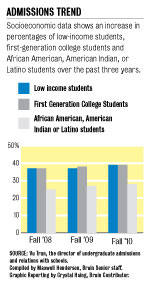UCLA is growing not only in terms of population, but also in its socioeconomic diversity, according to estimated figures from the analysis of its 2010-2011 freshman class.
Not only did UCLA admit and enroll more first-year students from low-income families, but early figures also showed very slight increases in the enrollment of underrepresented students. Complete data for this year’s freshman admittance profile has yet to be processed and will be released during Week 3.
These increases followed the trend established in the University of California report titled “Undergraduate Access and Excellence at UC,” released Friday, which analyzed admissions data across all 10 UC campuses.
The report found that the proportion of admitted students from low-income families, first-generation college students and underrepresented students, including black, American Indian and Latino students, has risen over the past three years. In comparison, UCLA’s proportion of newly enrolled low-income students rose just a half-percent.
“Given the economy with budget cuts and fee increases, we wanted to assess whether low-income students are being frozen out of the admissions process,” said Ricardo Vazquez, a UC spokesman. “We wanted to let students know that our doors are open.”
Vu Tran, director of Undergraduate Admissions and Relations with Schools, attributed the rising socioeconomic diversity to UCLA’s holistic admissions policy, which is designed to encourage students from all backgrounds to apply.
“When we recruit students, we recruit from all walks of life,” he said. “With admissions, family income and ethnicity, things like that are not factored in or taken into consideration, so UCLA has maintained a pretty stable rate of low-income students and minorities.”
In light of budget cuts necessitated by slashes in state funding, many UC campuses have compensated by reducing in-state enrollment.
However, UCLA’s ability to sustain relatively stable levels of low-income, minority and first-generation college students is due in part to the administration’s commitment to California residents, Tran said.
“UCLA has made a very conscious decision to not reduce the enrollment of California residents in spite of the budget cuts,” Tran said. “We’re overenrolled, but the administrators here wanted to support California residents as much as they could.”
With a rising proportion of students from low-income families, the UC has instituted changes in its financial aid program, making it easier for students to be eligible for programs such as the Blue and Gold Opportunity Plan.
The Blue and Gold Opportunity Plan now covers all student fees for students with a family income of less than $70,000. The income cap for eligibility was formerly $60,000. Additionally, financial aid will cover at least half the cost of the fee increase for students whose family income falls between $70,000 and $120,000.
Financial aid for these students will be funded through a combination of Cal Grants, Pell Grants and a percentage of the revenue from increased student fees, said Ronald Johnson, director of financial aid at UCLA.
Continued rising socioeconomic diversity within the UC system will likely result in further expansion of the Blue and Gold Opportunity Plan to assure that low-income and middle-income students have their needs addressed, Johnson said.
“It’s very important that we do have an economically diverse population of students,” Johnson said. “We’re a public institution, so that’s an objective that we have to achieve.”
